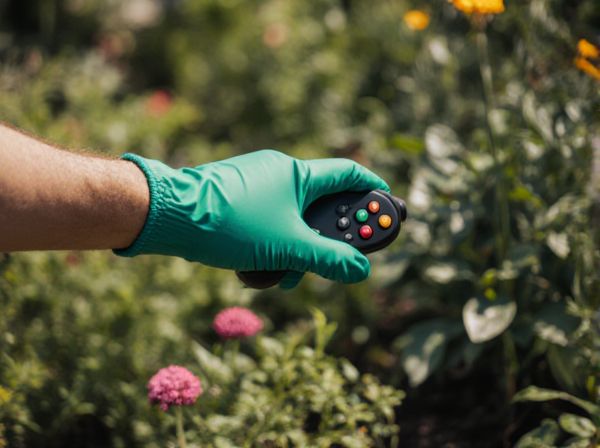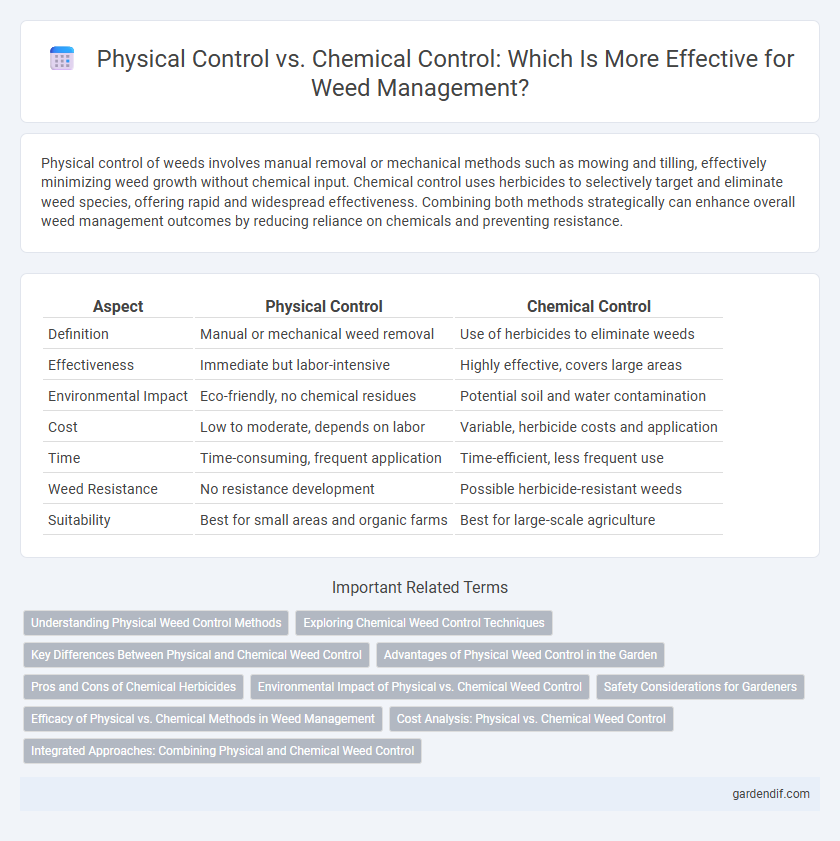
Physical control vs chemical control Illustration
Physical control of weeds involves manual removal or mechanical methods such as mowing and tilling, effectively minimizing weed growth without chemical input. Chemical control uses herbicides to selectively target and eliminate weed species, offering rapid and widespread effectiveness. Combining both methods strategically can enhance overall weed management outcomes by reducing reliance on chemicals and preventing resistance.
Table of Comparison
| Aspect | Physical Control | Chemical Control |
|---|---|---|
| Definition | Manual or mechanical weed removal | Use of herbicides to eliminate weeds |
| Effectiveness | Immediate but labor-intensive | Highly effective, covers large areas |
| Environmental Impact | Eco-friendly, no chemical residues | Potential soil and water contamination |
| Cost | Low to moderate, depends on labor | Variable, herbicide costs and application |
| Time | Time-consuming, frequent application | Time-efficient, less frequent use |
| Weed Resistance | No resistance development | Possible herbicide-resistant weeds |
| Suitability | Best for small areas and organic farms | Best for large-scale agriculture |
Understanding Physical Weed Control Methods
Physical weed control methods involve manually removing or disturbing weeds through tactics such as hand-pulling, hoeing, mowing, and tillage. These approaches target weed roots and shoots directly, reducing weed populations without the use of synthetic herbicides. Implementing physical control techniques effectively minimizes environmental impact and helps prevent herbicide resistance in weed species.
Exploring Chemical Weed Control Techniques
Chemical weed control techniques focus on applying herbicides that target specific weed species while minimizing damage to crops, enhancing overall agricultural productivity. Selective herbicides disrupt essential biological processes in weeds, such as photosynthesis or cell division, providing efficient eradication without extensive soil disturbance. Understanding herbicide modes of action and application timing optimizes control efficacy and reduces the risk of herbicide resistance development.
Key Differences Between Physical and Chemical Weed Control
Physical weed control involves manual or mechanical removal techniques such as tilling, mowing, or hand-pulling, which physically disrupt weed growth without introducing chemicals. Chemical weed control relies on herbicides that target specific biochemical processes within weeds, offering faster and broader-spectrum efficacy but with potential environmental and resistance risks. Key differences include the immediacy of results, environmental impact, cost-effectiveness, and the potential for weed resistance development.
Advantages of Physical Weed Control in the Garden
Physical weed control enhances garden health by minimizing chemical exposure to soil and plants, which preserves beneficial microorganisms and promotes biodiversity. It provides immediate removal of weeds, reducing seed spread and preventing future infestations without chemical resistance risks. This method is environmentally sustainable, cost-effective, and safe for children and pets, supporting organic gardening practices.
Pros and Cons of Chemical Herbicides
Chemical herbicides offer effective and rapid weed eradication, reducing labor costs and enabling large-scale agricultural management. However, their use can lead to environmental contamination, including soil and water pollution, and may cause herbicide-resistant weed species to develop. Careful application and integrated weed management strategies are essential to minimize negative impacts while maximizing crop yields.
Environmental Impact of Physical vs. Chemical Weed Control
Physical weed control methods such as mulching, tilling, and hand weeding reduce environmental pollution by avoiding synthetic chemicals and preserving soil health. Chemical weed control often leads to soil and water contamination through herbicide residues, impacting non-target species and biodiversity. Integrating physical control can minimize ecological risks while maintaining effective weed management in agricultural and natural ecosystems.
Safety Considerations for Gardeners
Physical control methods for weed management, such as hand-pulling or hoeing, offer a safer option for gardeners by minimizing exposure to harmful chemicals and reducing environmental impact. Chemical control involves herbicides, which require careful handling, adherence to label instructions, and use of protective gear to prevent skin irritation, respiratory issues, or accidental poisoning. Prioritizing physical control techniques can enhance garden safety while maintaining effective weed suppression without chemical residues.
Efficacy of Physical vs. Chemical Methods in Weed Management
Physical weed control methods, such as tilling, mowing, and hand weeding, provide immediate removal and reduce weed seed banks but may require frequent application to maintain effectiveness. Chemical control methods, including herbicide use, offer more consistent and long-lasting suppression of weed populations, especially in large-scale agricultural settings. Combining physical and chemical approaches can enhance overall efficacy by targeting different weed life stages and reducing resistance development.
Cost Analysis: Physical vs. Chemical Weed Control
Physical weed control methods like tilling, mowing, and hand weeding generally incur higher labor costs but lower material expenses compared to chemical control. Chemical weed control typically involves upfront costs for herbicides and equipment but can reduce labor and time over larger areas, resulting in lower per-acre expenses for extensive operations. Evaluating the cost-effectiveness depends on factors such as infestation severity, scale, labor availability, and long-term weed management goals.
Integrated Approaches: Combining Physical and Chemical Weed Control
Integrated weed management combines physical and chemical control methods to optimize weed suppression while minimizing environmental impact. Utilizing tactics such as mechanical tillage and selective herbicide application enhances efficacy and reduces herbicide resistance development. This synergistic approach promotes sustainable crop production and long-term weed population management.
Physical control vs chemical control Infographic

 gardendif.com
gardendif.com